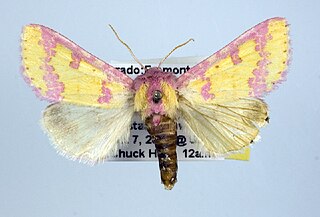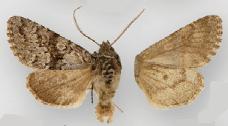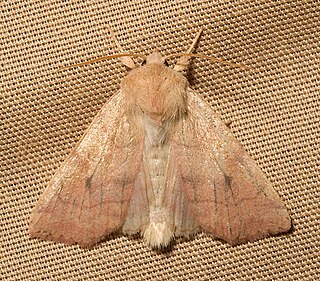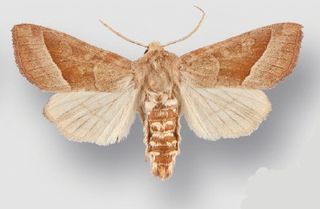
The Noctuidae, commonly known as owlet moths, cutworms or armyworms, are a family of moths. They are considered the most controversial family in the superfamily Noctuoidea because many of the clades are constantly changing, along with the other families of the Noctuoidea. It was considered the largest family in Lepidoptera for a long time, but after regrouping Lymantriinae, Catocalinae and Calpinae within the family Erebidae, the latter holds this title now. Currently, Noctuidae is the second largest family in Noctuoidea, with about 1,089 genera and 11,772 species. This classification is still contingent, as more changes continue to appear between Noctuidae and Erebidae.

Actebia fennica, the black army cutworm or Eversmann's rustic, is a moth of the family Noctuidae. The species was first described by August Michael Tauscher in 1806. It has a Holarctic distribution from Newfoundland through western Europe, Siberia, the Far East, Mongolia, northern China to Korea and Japan. In North America it is mainly found in the boreal region, south to New England, southern Montana and northern Oregon.

Lasionycta staudingeri is a moth of the family Noctuidae. It can be found from Oppland to Finland and Norway in Europe, as well as Siberia and North America.

Panthea virginarius, the Cascades panthea, is a moth of the family Noctuidae. It is mainly found west and north of the Great Basin, from the coast of southern California northward to the Queen Charlotte Islands of British Columbia and the Alaskan Panhandle, eastward to central California, northern Nevada, Idaho, north-western Wyoming, western Montana, and south-western Alberta. A disjunct population is found in the Cypress Hills of Alberta and Saskatchewan.
Cerastis fishii is a moth of the family Noctuidae. It is found in eastern North America from Newfoundland to southern Ontario in Canada. In the United States, it is found from western Maine to Ohio, Michigan, and northern Wisconsin, then south to North Carolina. It has also been recorded from Tennessee.

Diarsia rubifera, the red dart, is a moth of the family Noctuidae. It is found from coast to coast and from central and southern Canada and the northern United States. In the east it occurs as far south as western North Carolina, and in the west it has been recorded from south-western Montana and south-western Colorado. It has been recently recorded from Tennessee.

Eueretagrotis perattentus, the two-spot dart, is a moth of the family Noctuidae. It is found from coast to coast across central and southern Canada, and in the northern United States, south along the Appalachians to western North Carolina and Tennessee. There are a few scattered records along the Rocky Mountains from south-western Montana to south-eastern Arizona.
Lycophotia phyllophora, the lycophotia moth, is a moth of the family Noctuidae. It is found across southern and central Canada from New Brunswick and Nova Scotia to western Ontario, and in the northern United States from Maine to Minnesota, south to Ohio, and along the Appalachians to western North Carolina.

The clandestine dart or w-marked cutworm is a moth of the family Noctuidae. It is found from coast to coast across Canada to southern Alaska, and in the eastern United States from Maine to western North Carolina, west to northern Ohio to North Dakota, South Dakota, Nebraska, and down the Rocky Mountains from Montana to southern Arizona.

Euxoa adumbrata, the sordid dart, is a moth of the family Noctuidae. The species was first described by Eduard Friedrich Eversmann in 1842. In North America it is found across northern Canada from Quebec to western Alaska, south to the northern parts of the United States, and in the mountains to Colorado. It is also found in Greenland, the coastal areas of Scandinavia and the Ural. It was recently recorded from Denmark, although this includes Euxoa lidia, which some authors regard to be a valid species.

Psectrotarsia suavis is a species of moth of the family Noctuidae. It is found from south-western South Dakota, extreme north-eastern and western Nebraska, northern and south-western Kansas, eastern Colorado, New Mexico east of the Rocky Mountains, southern Arizona, and the panhandles of Oklahoma and Texas and in south central and south-western Texas. There are two records from Mexico, one from Chihuahua and one from San Luis Potosi.

Lasionycta luteola is a moth of the family Noctuidae. It is found from northern Washington and south-western Alberta northward to south-western Yukon.

Lasionycta subfuscula is a moth of the family Noctuidae. It is found from south-western British Columbia and south-western Alberta south to southern Oregon in the west and to southern Colorado and Utah in the Rocky Mountains.

Enargia infumata, the lesser eyed sallow, is a moth of the family Noctuidae. It is found from Alaska and New Brunswick to Ontario, south to Connecticut in eastern North America. In western North America it is found from Saskatchewan and Alberta, south to Utah and California.

Rhyacia quadrangula is a moth of the family Noctuidae. It is found in Iceland, central Asia, the Pamir Mountains, Greenland as well as Canada and the north-western United States.

The Erebidae are a family of moths in the superfamily Noctuoidea. The family is among the largest families of moths by species count and contains a wide variety of well-known macromoth groups. The family includes the underwings (Catocala); litter moths (Herminiinae); tiger, lichen, and wasp moths (Arctiinae); tussock moths (Lymantriinae), including the arctic woolly bear moth ; piercing moths ; micronoctuoid moths (Micronoctuini); snout moths (Hypeninae); and zales, though many of these common names can also refer to moths outside the Erebidae. Some of the erebid moths are called owlets.

Hydraecia obliqua is a moth in the family Noctuidae first described by Leon F. Harvey in 1876. It is found in western North America, east to the Sierra Nevada in California and the crest of the Cascade Range in Oregon and Washington. It occurs continuously on the coast north to south-western British Columbia, with a disjunct northern population at Terrace, British Columbia. The habitat consists of the riparian zone along creeks and rivers of coastal rainforests, as well as oak savanna, mixed hardwood forests and valley grasslands.

Caradrina selini is a moth of the family Noctuidae. It was described by Jean Baptiste Boisduval in 1840. It is found in most of Europe, North Africa and the Near East.

Panchrysia aurea is a moth of the family Noctuidae. It is found in southern Europe and western and central Asia. The range extends from Portugal, east to Tian Shan, the Altai and the north-western Himalayas. In central Europe, it is found in the southern Alps, lower Austria and the mountains on the Balkan Peninsula.

Stiriini is a tribe of owlet moths in the family Noctuidae. There are about 16 genera and more than 90 described species in Stiriini.














